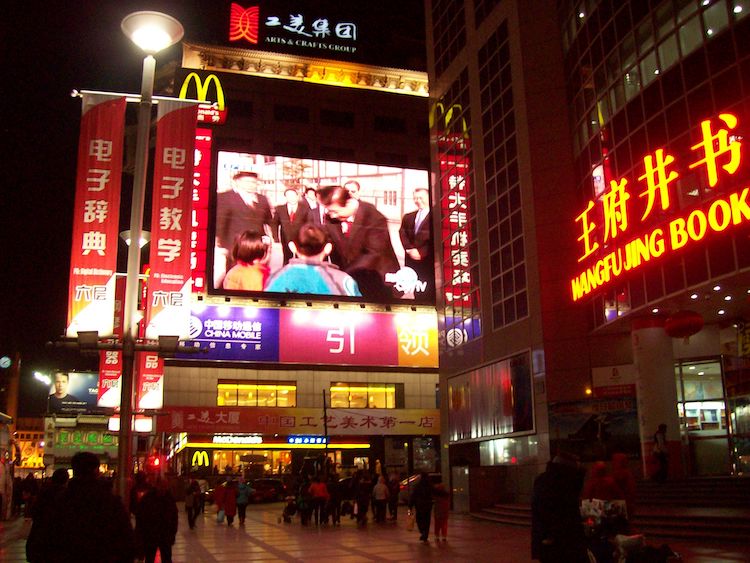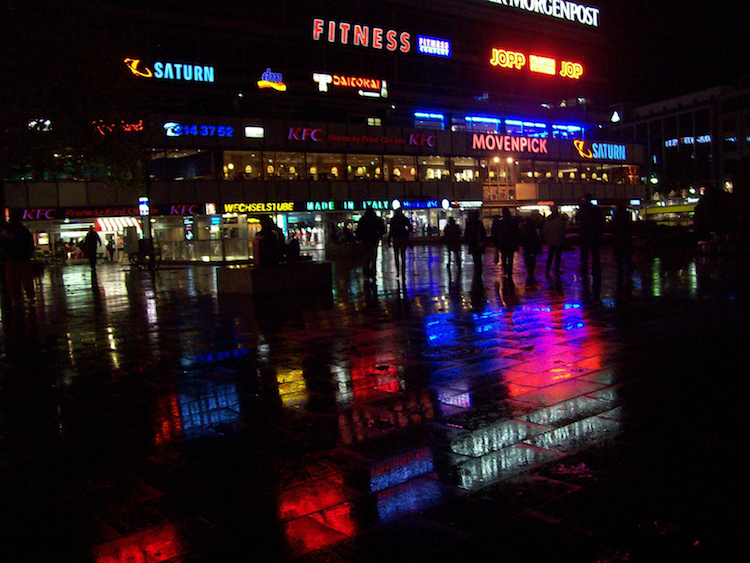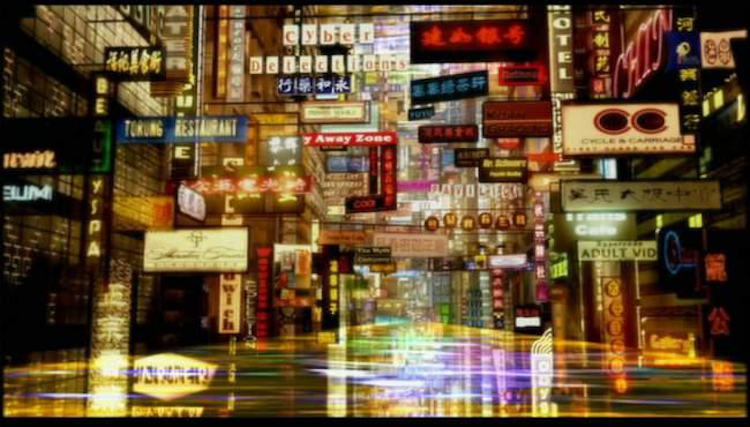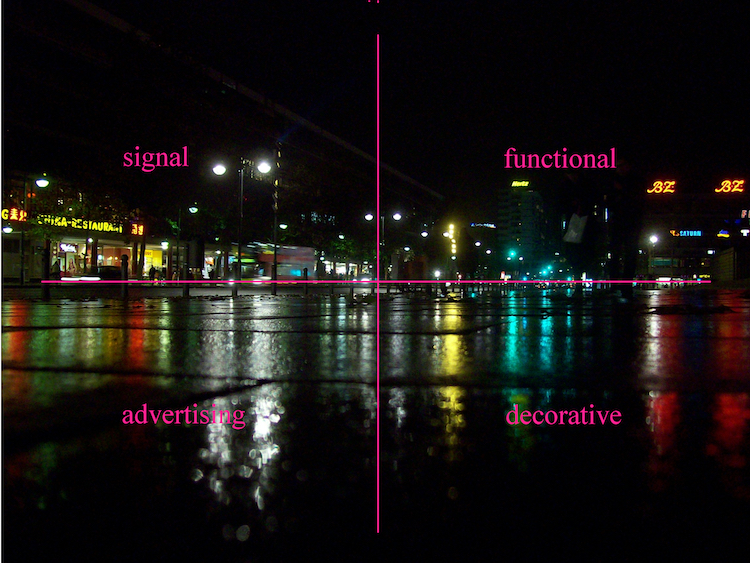
Hypercities: visual context in the postnocturnal city
– Petros Dermatas
-
Abstract
The following research paper intends to examine the diffusion and reception of electric light within the context post-nocturnal city. Primarily focusing on the hegemony that electric light has exercised over the human visual system; the purpose of this paper is to examine how electric light has influence society today and tomorrow and create the framework for further research. My hypothesis suggests that when electric light entered the public sphere, it led human perception in a state of hyperreality.

1. Wangfujing Shopping Street – Beijing China. Petros Dermatas (2008)
Introduction
Before the industrialization of society, life was governed by the natural rhythms of day and night. The levels of brightness and darkness, of our diurnal and nocturnal experience, were regulated by the presence or absence, of the celestial luminous bodies: the sun, the moon and the stars. The archaic fire, original source of domesticated light, overcame darkness and advanced the process of human evolution, playing a decisive role in the development of human culture. As a result, humanity would develop its neurological and biological association to the environment, under the influence of these circumstances.
It is has only been in the short period of the last 250 years, that mankind has experienced a rather unusual overexposure of artificial light during the night. First in the form of gas lighting, and then in the form of electric light. The regular use of flame as a light source, lasted roughly up to the end of the 19th century, when electric light ultimately took over. This overexposure of the nightscape to electric light technology, changed the aforementioned balance in an irreversible manner. What were the transformations that occurred with the arrival of electric light? How did electric light change our understanding reality? What were the consequences of this change?
The introduction of state-of-the-art electric lighting, first took place in the commercially operated amusement parks. Luna Park (1903), and Dreamland (1904) in Cony Island New York, initially forged the association of “hoi polloi” with the effects of electric light, reflecting the microcosm of a new emerging culture. The International Expositions and World Fairs, had provided earlier the “testing grounds,” for grand scale illumination works. In the Exposition Universelle of Paris (1889) and the Chicago World Columbian Exposition (1893), the new culture was declared! Offering the masses a trance of “fairy tracery” and “gilded nights.” When this culture was transferred to the street, it transformed the image of the city ‘riot of colors, more like a dream city than a real one ” .1
A medium suggests something which lies in between, an intermediate. This paper, utilizes medium as any new technology, the totality of human created objects that extend the human body and senses. Once a medium has integrated itself within a society, it tends to disappear, we fail to notice its presence. Therefore, it is necessary to step out of the conceptual framework it has created, in order to be able analyse its effects. Electric light has been on the forefront of nocturnal visual mediation, for the last 100 years, it is virtually everywhere and nowhere; it is difficult to notice, because we take it for granted. Before electric light, other forms of light had mediated the nocturnal spatial array, but the circumstances were dramatically different. The contemporary nocturnal cityscape, does not really resemble any other nightscape at any point in time: i.e post-nocturnal. To imagine today, a world prior to electric light technology, is a world impossible to imagine.
In 1995, media and cultural critic Neil Postman, was asked on a television show to define cyberspace. “Cyberspace” he said “is the metaphorical idea, for where your consciousness is supposed to be when you are using computer technology, like the internet for example[…] The most interesting thing for me, is that it made me think, about where one’s consciousness is located when interacting with other kinds of media. For example: When you are reading a book, where are you? Which is the space your consciousness is located? When watching television, where are you ? Who are you?” Ergo which is the space one’s consciousness is located when enveloped within the post-nocturnal cityscape? Where are we? Who Are we?
In order to see, a light source is required. Without light, everything is black. Light emits photons which reach the eye and bounce-off objects enabling us to see. Vision on the other hand, provides decisive information regarding the existing world, light reaches the eye, and is transformed into an electrical signal that travels to the visual centre of the brain, in order to form a picture of the outside world. Hence if light functions as a layer of interpretation, and visual reality is dependent on the stimulus the eye receives: In the nocturnal state of the city, it is electric light in all its expressions, that takes control over the visual stimuli, and dictates the images produced in the brain. Our consciousness, is thus thrown into presentation of reality, mediated by electric light. A black canvas with inputs of information, patches and patterns of light here and there. Enfolded within the postnocturnal experience, our understanding of the environment, is attuned to the imputes of electric light, which is actively structuring our sense of form and space, while in parallel manifesting spatial qualities that influence human emotions and behaviour

2. Europa-Center, Breitscheidplatz Berlin Germany. Petros Dermatas (2008)
The medium is the message
-
“Not what the moving red neon sign says —but the fiery pool reflecting in the asphalt.”
–Walter Benjamin
In “This Space for Rent” circa-1920 Walter Benjamin wondered: “What in the end makes advertisement so superior to criticism” to reply: “Not what the moving red neon sign says — but the fiery pool reflecting in the asphalt.” Anticipating Marshall McLuhan’s famous diction: “the medium is the message” some 40 years earlier. In Understanding Media: The Extensions of Man, McGraw-Hill, New York, NY, 1964, Marshall McLuhan argued that in the examination of media what has premise is not the message per se but the medium. In other words, the medium is the message. The effect a medium has on people and societies, is always more important than the message it carries. Namely the way we acquire information, affects us more than the information itself. The content of a medium, typically blinds us, to its personal and social effects. In essence, what McLuhan wanted to communicate, was the simple fact that technologies change us, alter the way we think, and interfere with our nervous system. Any new technology, will shape and filter our experience, according to its own bias, reducing our sensory experience, to fit its own reality. As a result, while forced to adapt, new patterns of thought and behaviour emerge; reorganizing the way we perceive and communicate, with the world around us. Hence the real message of any technology, is the change it evokes in human life, changing in effect human nature.
In fact, McLuhan found the perfect metaphor to describe his axiom, in electric light technology, a medium literary without a message. Electric light he said is pure information: “Whether the light is being used for brain surgery or night baseball is a matter of indifference […] because it is the medium that shapes and controls the scale and form of human association and action.”2 In other words, the content of electric light: i.e, nocturnal activity, cultural spaces, architectural effects, advertisement etc. is besides the point. What primary matters instead, is the structural change that electric light, has set to the human nervous system. By introducing previously non existent (nocturnal) space, electric light, reconfigured our everyday experience, altering its dynamics, and changing individual and collective behaviour and thought. Thus, redefining our perception of time and space, electric light changed our relationship with the night, which now, no longer signalled the end of human activity. Extended by electric light, our capacity for work and leisure became limitless, and as a result, the 24 hour society emerged. The new status quo, changed the previous existent social and economic balance, reshaping the way we perceive and experience the world, and in effect, how we individually and collectively think and communicate with each other. Projecting its own values and pace, electric light, forced us to adapt, to a new reality, a reality it had itself created. The bias of electric light, literally transformed architecture, and shaped the build environment. The content of the new reality, no matter how powerful, influential, good or bad, was incidental, what primary mattered instead was the change that electric light had brought to human lifestyle, redefining in essence what it meant to be human. What were the consequences of human activity within this novel territory?
Interaction with any medium, inevitably comes with a cost. The medium, will always amplify or ease specific sense ratios essential to its task. The introduction of electric light, namely challenged the human ocular system, subjecting it to dramatic change. Amidst a bombardment of luminous stimuli, the overexposure of our nocturnal experience to electric light technology, favoured the sense of vision, promoting an ocularcentric society, in the disadvantage of other sense ratios i.e audio, tactile that were more active before. In effect, electric light changed the human condition, reorganizing sense ratios while forcing the visual territory of the brain to accommodate this change. Yet, if we were to examine the consequences of the shift from flame to electric light technology, we would arrive to the conclusion that the human nervous system, responded to the shift in electromagnetic radiation, not the content i.e what we see. Previous generations, were attuned to the particular spectrum, emitted by the light from the celestial luminous bodies, and the controlled use of fire. Abundance of electric light,on the other hand, conditioned us to spend more time indoors. Our new lifestyle consequently, removed us from the spectrum of natural light, driving us into artificial lit environments. Natural light and artificial light, on the other hand, are quite different elements. Nevertheless, prior the introduction of electric light, the spectral quality of artificial light, was not much different from sunlight. Electric light, brought about an electromagnetic shift, forcing the human brain to an analogous structural change, in order to adjust to the new reality. Namely, our brain went through a organizational change, in order to accommodate the bias of the electric light, altering if effect human nature.
Humanity, developed its neurological and biological association to the environment, in harmony with the natural rhythms of day and night. In effect, humans would evolve into diurnal creatures, entrained to be active during the day, while inactive/sleeping throughout the night. This archetypal pattern led to the emergence of an internal/biological clock, tuned to the cycles of day and night. Hence biological/ circadian rhythm is the mental, physiological, and behavioural processes, that occur, in response to the periodicity of the levels of light and dark in the environment. Darkness, signals our bodies to produce melatonin, a hormone that helps us sleep, while daylight inhibits it. In the postnocturnal condition, electric light has dramatically decreased the levels of darkness, disorganizing our biological clock. Disturbing natural sleep patterns, in effect, leads to health issues besides dysfunctionalities in brain and body operations. When electric light enters the eye, our brain is signalled to be active, dropping melatonin levels, therefore stimulating human activity. As a result, our biological clock is readjusted, due to the change in the levels of light, not the content of our experience. The type of light, that passes through our eyes, also determines important cellular and biochemical reactions For whatever reason, electric light may be applied for, our nervous system, will always detect the difference in quality and light levels, as opposed to the content we experience within the environment created by electric light. In other words, the message of electric light whatever that may be, is never as important as the effect electric light has on people as a medium itself.

3. Still from Cyberwars : Sci-Fi Drama (2004), Cinemancer Pte Ltd. [sg]
Postmodern hype
-
“All spaces have been colonized, not just all geographical spaces but all mental ones too”
–Jean Baudrillard
While McLuhan, warned us that it is the change new technologies force upon people, that is more important than the message they carry; this does not dismiss the effects of content altogether. Technologies will violently reshape and transform a society, whereas beliefs and ideas, however powerful, take time to sink in. In this part, we will examine the message of the medium, i.e. the content of the environment created by electric electric light. Applying postmodern analysis, we will examine how the post-nocturnal cityscape, by controlling the flow of information and images, has culturally conditioned the postnocturnal environment, influencing in effect human identity and behaviour.
Modernism, represents the era of enlightenment, where reason and science were thought to explain everything. Postmodernism on the other hand, raised a radical critique, against the fundamental ideas of modern thought itself. Suspicious of classical notions such as truth, reason, objectivity, identity, morality etc. The generation of young post WWII intellectuals, introduced a new form of scepticism, which sought through close examination, to destabilise and decompose previous theories and truths. While in the modern era, technology was considered the road to prosperity, for the postmodernists already familiar with the horrors of WWII, (concentration camps, atomic bomb) this belief seized to exist. Technological progress had a dark side, and represented an iron cage of our own making. For the postmodernists, the very ground of producing thought itself, was marginalized by systems of thought, institutions and culture. It could never be possible, for an individual to step out of these margins, and express a unbiased view. Human behaviour was determined by social structures, and society through its ideologies and technologies, moulded the individual in its own image. In the same rational, language was not a “mirror of nature,” but a medium of communication, a system of signs determined by human convention. Language, semantically self-contained, and self-referential as it was, could not represent an reality outside itself. In contrary it was language which was actively constructing what it communicated.
In the light of this framework, philosopher and media theorist Jean Baudrillard, developed his own radical ideas. Examining, the impact of consumer culture on society and human identity, Baudrillard looked upon objects, as carriers of information, or a system of signs. Like the other postmodernists, Baudrillard, believed that the language communicated through the consumer environment, imposed meaning on the individual and constructed the perceived reality. But for Baudrillard, so the massive was the production and consumption of signs, that in fact it occurred in hyperreality. The more faithful, and flawless societies sought to bring reality together, the more reality disappeared. “More real than real.” The subject, could try to comprehend the object, but impossible as this was, when people were seduced into thinking the opposite they enter a simulated version of reality or the state of hyperreality. In Baudrillard’s view, the subject had merely become “a pure screen a pure absorption and reabsorption surface of the influential networks.”3
The novel condition that the human visual system was forced to negotiate with, as a result of the development of gas lighting, would only be the preface of a violent proliferation of imagery, designated to forge and organize the visual territory of the post nocturnal milieu. From the functionality of street lighting, the illumination of civil monuments and electric lighting in hotels, cafés, bars , restaurants and shops, to illuminated advertisements and theatrical marquises. Electric light augmented its presence and increased its dencity, conditioning what was to be seen, shaping visual boundaries and creating a new reality. The newly-lit frontier, would bring along an abundance of new information and images which fed the imagery of the mind. What were the consequences of the shift from gas light technology to electric light technology?How introduction of electric light technology change the fabric of nocturnal reality?

4. Contextual division of the postnocturnal spatial array
Yet according to the postmodern view, there is no correspondence between language and the information it transmits. Language, semantically self-contained and self-referential as it is, can not signify a reality outside itself. In the same line of thought, the post-nocturnal image of the city, does not represent a reality outside itself. It is visually constructing and imposing meaning on the individual. Electric light, essentially shapes the nocturnal reality, through the input of luminous information it transmits to the visual centre of the brain. Like language, ideology and culture, which mould the individual in their own image, so does the post-nocturnal cityscape shape individual and collective perception in its presentation of reality. Functioning as a layer of interpretation, electric light projects its own values, configuring spatial ambiance according to its own bias, molding our experience and influencing human behaviour, emotion and identity.
Postmodern society, drawing from culture and media, has replaced all reality and meaning with symbols and signs, generating a simulation of the real, rather than reality itself. ”the generation by models of a real without origin or reality.”4 Most evident in the technologically advanced societies, the frantic civic habitation of electric light, has led to the implosion of the 24-hour circle, and the collective construction of another order, an order which structures our sense of space-time and mapping of the post-nocturnal city. It is this hyper mediated visual rhetoric which is radically shaping our way of understanding, in its own construction of reality. We are consumers of images, icons, signs of the simulated reality that takes hold of the city at night, there is no more night. Hence the postnocturnal state of the city, although expected to represent something, has instead created the reality it seemingly refers to, and thus has passed to the state of the hyperreal, or the simulation of a city that never really existed.
-
Appendix
Video by Petros Dermatas
Notes
1. Raymond Hood : ”Architecture of the night: the illuminated building” Dietrich Neumann, Kermit Swiler Champa, p.55
2. Understanding Media: The Extensions of Man, Marchal McLuhan, p.8
3. The Ectacy of Communication, Jean Baudrillard, p.27
4. Simulacra and simulation (1994) Jean Baudrillard, p.1
References
– McLuhan, Marshall, Understanding Media: The Extensions of Man, McGraw-Hill, New York, NY, 1964.
– Postman Neil, Amusing ourselves to death : public discourse in the age of show business, Penguin Books, New York, N.Y, 1986.
– Baudrillard Jean, Simulacres et Simulation, Éditions Galilée, Paris, 1981.
– Baudrillard Jean, America, Verso, London, 1996.
– Baudrillard, Jean. 2012. The ecstasy of communication. Semiotext(e), Los Angeles.
– Neumann Dietrich; Champa Kermit Swiler; Architecture of the night : the illuminated building, Prestel, Munich 2002.
– Wurtman, R.J (1975) The effects of light on the human body. Sci. Am., 213, 50-60
Petros Dermatas is a lighting designer with a MSc in Architectural lighting design from KTH Sweden. The following research paper has been under development since early 2010. It has been accepted for a poster presentation, in 2011 for PLDC Spain, while has also been presented as a lecture at the KTH Lighting Laboratory in Sweden, in 2012. In 2008, Petros won the Vox Juventa best speaker award upon presenting his master thesis: “The History of Artificial Light and the Inherent. Socio-Political Aspects in Western Civilization.” Since then he has continued to develop his research in both obscure and uncharted aspects of artificial light.
Volume 1, no. 3 Autumn 2017
